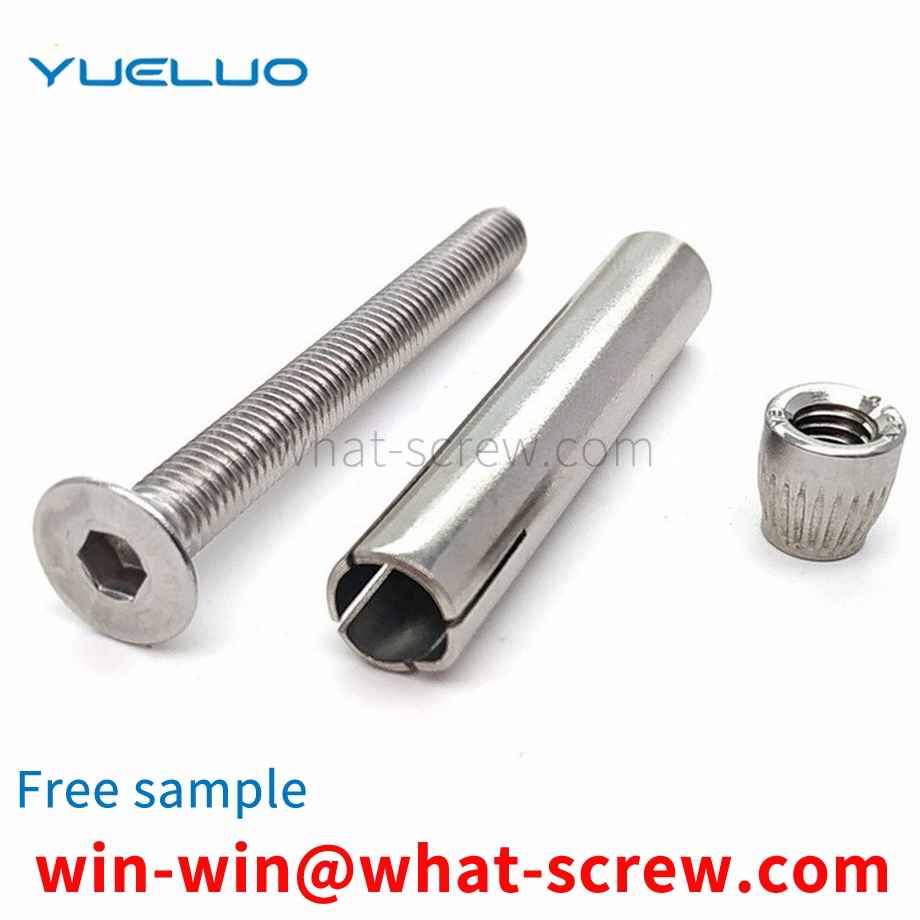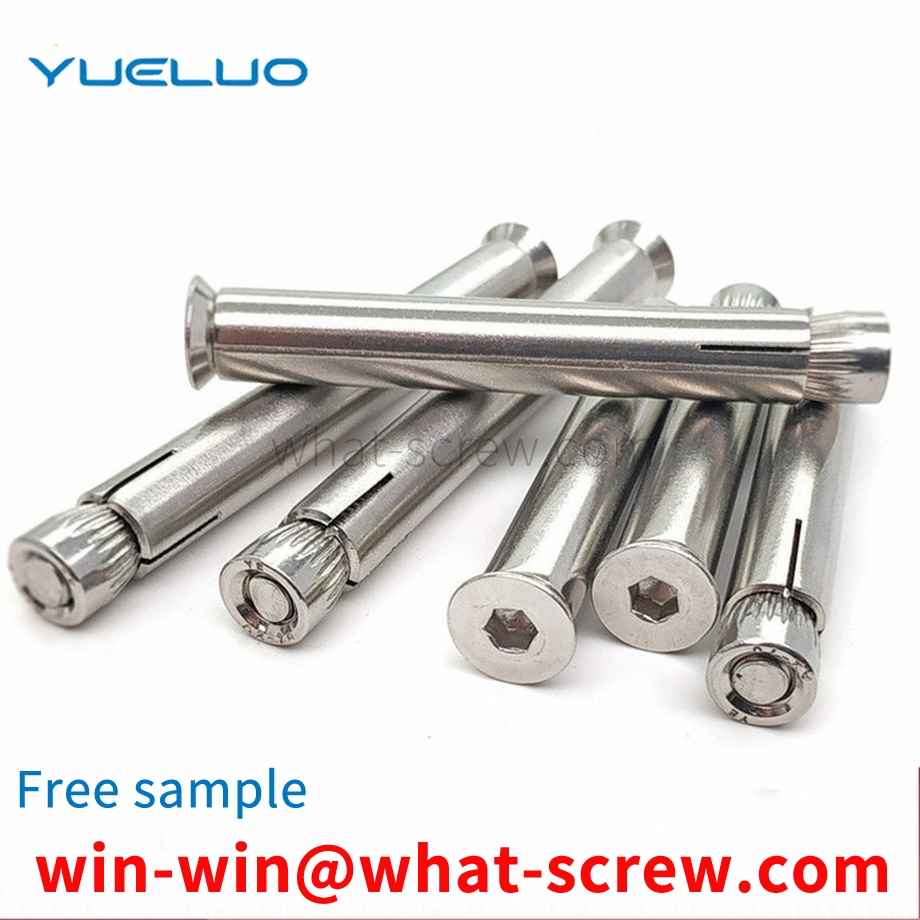Guangdong Yueluo Hardware Industry Co., Ltd. has a simple structure, low processing difficulty, and convenient riveting. The whole pin has the same diameter except for the annular groove. The drawn wire can be directly used, which saves the cost of materials and machining costs, and improves the production speed and efficiency. The structure does not require high machining accuracy of the hole, which can effectively reduce the machining cost and the rework rate of the parts.
In order to meet the requirements of anti-loosening bolts of parts with small surface hardness such as plastic parts, Yueluo provides a spring washer and the installation structure of the spring washer, which can effectively reduce the damage of the spring washer to the surface of the parts. And meet the anti-loosening effect of the spring washer. The technical solution provided by Yueluo is a spring washer, which includes a washer body with at least two raised claws on the washer body
The main categories of screws include ordinary screws, machine screws, self-tapping screws and expansion screws. Cap screws used to be limited to full-thread fasteners. Hex cap screw and Hex bolt Hex bolt As the name suggests, it is a male threaded fastener with a hexagonal head, designed to be turned with a wrench. According to the ASME B18.2.1 standard, the head height and shank length tolerance of the hexagon head screw (Hex cap screw) is smaller than that of the general hex bolt (Hex bolt), so the ASME B18.2.1 hexagon screw is suitable for installation in all hexagon bolts that can be used. places, also including places where the large hex bolts are too large to be used. Socket cap screw (also known as socket head screw or) is a screw with a hexagonal inner hole on the head, which can be tightened or loosened only after a hexagonal ruler (hex key, Allen wrench or Allen key) is inserted into the inner hole. The most commonly used hexagon socket head screws are cylindrical head screws with a head diameter of about 1.5 times the main diameter of the thread (1960 series). Countersunk head cap screw. The counterbore design allows the screw head to rotate without being exposed on the surface of the fixed object, so it is mostly used in places where the surface is small and traditional wrenches are inconvenient to use. Machine screw is generally a screw (4#~12#) with a diameter less than ¼ inches, usually full teeth and rotated by a screwdriver, such as slotted, cross or hexagon socket. Wood screws, machine screws; but can be divided into many categories according to different uses; machine screws can be divided into longitudinal tightening screws and horizontal expansion screws; according to the thread can also be divided into: A: Triangular thread (60 degrees ) : combined/locked/expanded B: triangular thread for pipe (55 degrees): combined/locked 3) C: trapezoidal thread (30 or 29 degrees): power transmission D: square thread (90 degrees): power transmission stainless steel screw Stainless Steel Anti-Drop ScrewsStainless Steel Anti-Drop Screws Machine (Treadmill) Screws And Shafts For Motorcycle Or Bicycle Needle Car Screws, Axes Screws And Shafts For Sewing Macing Socket Set Screws Stainless Steel Wide Thread ScrewsStainless Steel Coarse Thread Screws Stainless Steel High-Low Thread Screws Stainless Steel Machine Screws Stainless Steel Self Drilling Screws Stainless Steel Self Tapping Screws Stainless Steel Self Tapping Screws Stainless Steel Thread Cutting Screws Stainless Steel Triangle Stainless Steel Tri-Lobular Thread Screws Model Description P refers to the head type is PAN head; A refers to the pointed tail teeth, B refers to the flat tail teeth, namely PA round head pointed steel teeth, PB round head flat mouth steel teeth. Self-tapping type: ◆Round head self-tapping screw PA ◆Round head flat tail self-tapping screw PB ◆Round head cutting tail self-tapping screw PT ◆Round head belt self-tapping screw PWA ◆Round head belt and flat tail self-tapping PWB ◆Round head belt Jiecut tail self-tapping PWT ◆Countersunk head self-tapping screw KA ◆Countersunk head flat tail self-tapping screw KB ◆Countersunk head cut-tail self-tapping screw KT ◆Semi-countersunk head self-tapping screw OA ◆Big head self-tapping screw BA ◆Big head flat tail self-tapping screw BB ◆Large flat head self-tapping screw TA ◆Large flat head flat tail self-tapping screw TB ◆Large flat head cutting tail self-tapping screw TT ◆Thin head self-tapping screw CA ◆Thin head flat tail self-tapping screw CB ◆Cup head hexagon socket self-tapping HA ◆Drywall/Wallboard/Fiber Nails Machine Wires: ◆Round Head Machine Screw PM ◆Round Head Machine Screw PWM ◆Large Flat Head Machine Screw TM ◆Countersunk Head Machine Screw KM ◆Half Countersunk Head machine screw OM ◆Large head machine screw BM ◆Thin head machine screw CM ◆Cup head machine screw HM
Although there are many types of self-tapping locking screws, they all have the following main characteristics: (1) Generally, they are made of carburized steel (accounting for 99% of the total products). Also available in stainless steel or non-ferrous metals. (2) The product must be heat treated. Carbon steel self-tapping screws must be carburized, and stainless steel self-tapping screws must be solution hardened. In order to make the self-tapping screw meet the mechanical properties and performance required by the standard. (3) The product has high surface hardness and good core toughness. That is, inner softness and outer rigidity. This is a major feature of the performance requirements of self-tapping screws. If the surface hardness is low, it cannot be screwed into the matrix; if the toughness of the core is poor, it will break as soon as it is screwed, and it cannot be used. Therefore, inner softness and outer rigidity are the requirements for self-tapping screws to meet the performance requirements. (4) The surface of the product needs surface protection treatment, generally electroplating treatment. Some product surfaces require phosphate treatment (phosphating). Such as: wall panel self-tapping screws are mostly phosphating. (5) It is produced by cold heading process. It is recommended to use high-speed cold heading machine and high-speed thread rolling machine or high-speed planetary thread rolling machine to ensure product quality. The self-tapping screw produced in this way has a well formed head and high thread quality.
The elastic cylindrical pin, also known as the spring pin, is a headless hollow cylindrical body, which is slotted in the axial direction and chamfered at both ends. It is used for positioning, connection and fixation between parts. The outer diameter of the spring pin is usually slightly larger than the mounting hole. The deformation force generated by the elastic cylindrical pin to be restored to its original state by extrusion ensures the clamping effect of the elastic cylindrical pin. But just because of its clamping effect, it will play a big obstacle to the disassembly of the elastic cylindrical pin. When in use, the open end is extended out of the through hole on the pin shaft, and the open end is flared and separated to prevent the elastic cylindrical pin from sliding off the pin shaft to realize the function of preventing backlash. At present, the disassembly method of the elastic cylindrical pin usually uses a punching machine to remove the cylindrical pin, which easily destroys the equipment installed on the cylindrical pin, and the disassembled elastic cylindrical pin cannot be used again due to damage. One method is to insert the mounting pin with the clearance fit of the mandrel, punch the pin behind the mandrel to clamp the bottom of the cylindrical pin, and then pull out the cylindrical pin, which can only be used when the elastic mounting pin is installed in the through hole, and because it is necessary Applying force to the mandrel increases the difficulty of disassembly and increases the work intensity of the installer. Three methods are done by the installer using two needle nose pliers. Specifically, first use needle-nose pliers to clamp the ends of both sides of the elastic cylindrical pin, and then apply an inward force to the needle-nose pliers, so that both sides of the elastic cylindrical pin rotate in the same direction until the opening becomes smaller, and then Pull it out to remove it successfully. The defects of these existing methods are obvious. The shape of the disassembled elastic cylindrical pin is either unusable or the deformation of the cylindrical pin after disassembly is not uniform, which seriously affects the performance of the elastic cylindrical pin, resulting in waste and increased cost; The method is purely manual work, and sometimes it takes several repetitions to remove the elastic cylindrical pin. Due to the different installation positions of the elastic cylindrical pin, it sometimes increases the difficulty of disassembly, and it is difficult to remove the needle-nose pliers effectively. The pliers are difficult to construct, and the elastic cylindrical pins are easily damaged. If there are too many elastic cylindrical pins to be disassembled, the existing methods are often difficult to meet the needs, which not only consumes a lot of time and physical strength of the installer, but also makes it difficult to ensure the quality.
We have many years of experience in the production and sales of screws, nuts, flat washers, etc. The main products are: multi-axis through the fuselage frame light tie rod connection nut column, lengthened cylinder head bolt, 2-type u-bolt, pull nut and other products, we can Provide you with the right fastener solution for you.



















 Service Hotline
Service Hotline




